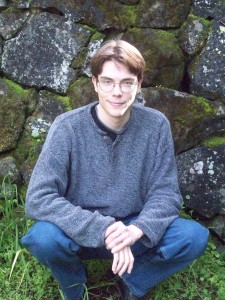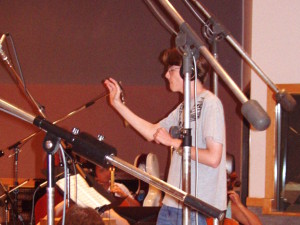Film music exists to support and enhance the story. By creating emotion or underscoring action, music pulls the viewer into a far more satisfying experience of story. Historically, music did this for silent film long before actors’ voices were heard.
We reached San Francisco-based film music composer Thomas VanOosting, who brings to the table (keyboard?) 10 plus years of experience composing for features, documentaries and animated shorts. His most recent work includes co-writing the score for PBS’s Lincoln: Prelude to the Presidency, and the upcoming Columbine documentary 13 Families.
SUPPORTING THE STORY

Thomas VanOosting
When asked how he creates music to support story, VanOosting said, “First of all, I try not to over think it. As much as I can, I try to rely on my first instinct when I look at a film clip.”
VanOosting believes that whatever he’s feeling initially when he views a scene, there’s a good chance that someone else is going to feel the same. When the scene is good he works at augmenting that feeling. When the scene isn’t quite working, he’ll try and alter the feeling to some degree with his music.
Structuring the music isn’t too much of an issue, he says. “The scene will dictate the structure for you.” Van Oosting watches the scene several times, aiming to get it into his system. “And then I rely on my subconscious to remember where the important beats are.”
He finds this a bit counterintuitive because some composers will actually map out the hit points in their sequencer program. For VanOosting this can at times detract from making the score sound like music. For example, he says, if you know the hero drops his pencil on beat three, and you know you’ve got to accent that, then you’re probably going to have that in mind as you’re writing. In other words, you’re writing to the action – a perfectly valid approach, he adds. And that’s what many composers do.
“But what I do,” he says, “is I write the music by itself for several measures. I try not to worry about the picture or even check it. Then, when I’m finished, I look at the music and image together.”
Working this way, he often discovers that the music has already accented the pencil beat without his realizing it. “But at the same time,” he says, “I’ve allowed myself to write a nice musical phrase.” He realizes that in this situation he’s internalized the rhythms of the scene by watching it a few times first. Then he’s given himself permission to “forget” about what he’s just seen. In effect, he’s relying on his subconscious to remember the beats.
CREATING EMOTION
When a composer is writing to a scene, he needs to worry about two things: writing to the action, or writing to emotion. VanOosting feels that writing to emotion is almost always more satisfying to the listener.
To capture this moment of satisfaction, VanOosting initially writes what comes to him. “Maybe it’ll feel right, maybe it won’t,” he says. “Usually it won’t feel quite right. The emotion will either be too on-the-nose or it’ll come up shallow.”

VanOosting at work
This brings him to what he considers the fun part – revising. He may add instrument layers to give the phrase “more color variety.” This can create a more subtle emotion, he feels. “Or I can take away layers and… accent certain colors. It drives the point home.”
VanOosting acknowledges the basic rules in film music, such as using a major key to create happiness and a minor key for sadness. He immediately adds, however, that rules like these are simplistic and don’t always apply. “I don’t think there’s any one concept that defines emotional writing. It’s more a matter of experimenting and measuring your own emotions. Is it hitting? Is it too melancholic? Is it too subtle? Most of composing is about making little adjustments. It’s like cooking. You won’t know you’re using too much butter until… you are.”
DIFFICULT COMPOSITION SITUATIONS
VanOosting finds writing for specific situations easier because you have fewer options. “If you’re writing for a romance,” he says, “you’re not going to be writing thriller music.”
When he’s writing for himself, when he’s writing just for fun, it’s much more difficult. “You’re options are endless,” he says. The more options, the harder the job. But he often prefers it this way. “Sometimes I like to be given free reign.” It opens up options which make things more difficult. “But you’re also being given an opportunity to go for a unique sound.”
THE PRODUCTION PROCESS
VanOosting usually gets called in after the picture has been locked and there’s no more editing to be done. He prefers it that way. If he gets called in too early in the process, he may end up writing for scenes that are cut before the lock. Even if he’s only writing the music in his head, he’s still wasting creative effort.
“I suppose one advantage to that,” he says, “is that I’ll be writing more thematic material and less scene specific material.” VanOosting has heard that sometimes John Williams works that way. (Williams is, of course, known for composing scores for Jaws, Superman, the Star Wars saga, ET, Jurassic Park, and the first three Harry Potter movies.) “He’ll write a movie’s theme based on a script or story first. And then he’ll fill in the rest once he sees the picture. But I think that’s pretty rare.”
WORKING WITH A DIRECTOR
“I love it when directors give me full creativity. But only if they mean it.” In his experience, he’s not given full creativity until a director feels he’s musically trustworthy.
VanOosting certainly doesn’t mind being given specific direction if the director has specific thoughts. However, he says it’s fairly common for directors to first give him creative reign, then change their minds and offer specific direction. That slows him down, he says. “My favorite projects are when I’m allowed to write quickly and creatively. Boom. It’s done.”
“The most difficult situations,” he says, “are when you and the director aren’t seeing eye to eye. That’s more of a collaborative problem than a composing problem though. Because if you’re not speaking the same language as the director, then the compositions you write are really going to be hit-or-miss.”
FILMMAKERS WITH LIMITED BUDGETS
Filmmakers with a small budget have several options, according to VanOosting. First, a filmmaker can approach student composers who are probably willing to help out for free. “Nothing wrong with that… to a point,” he says. Secondly, they can try licensing. Licensed music won’t be written specifically for your project (and therefore not original), but VanOosting feels it’s still perfectly valid. “Think about directors like Stanley Kubrick or Quentin Tarantino. Their movies are filled with licensed tracks. And those pieces fit surprisingly well.”
VanOosting states that there are risks for a filmmaker in not purchasing original music. “You’re more likely to sound like everyone else. And then, little by little, movies tend to give off the same vibe.” As an example, he says, listen to action music today. “Most of it sounds like CSI mixed with Gladiator.” That’s not a bad combination, he admits. “But if everyone’s doing it, then it starts to sound bland.”
VanOosting believes you should go for something more unique. “When you hire a composer specifically for your project, you have an opportunity to go for a singular sound. And even if the sound isn’t what you originally had in mind, it’ll make your film more memorable.” Then he hits the mark. “Do you want to follow the trend or do you want to set the trend?”
WRITING YOUR OWN MUSIC
Finale is VanOosting’s program of choice. He starts with the basic elements of a musical phrase: melody, harmony, tempo and rhythm. Then he says you’ve got to think about where you’re coming from emotionally and where you’re going.
“There’s a lot to think about as you’re writing, but if you’re focused on it too consciously, then you’re liable to get frustrated. The elements are there for you to have an understanding of them. But they’re not rules. The less you’re worried about doing things properly, the greater the likelihood that you’re going to discover your own sound.”
STRUCTURING A PIECE
“I try to think of it like poetry. How often should I repeat the A theme? When do I change to the B theme? What’s the rhyming pattern? The easy answer to this is simply to copy someone else’s structure. (Not the notes!) That’s a great way to learn what works. There are a few rules of thumb out there. For instance one of them is that you can repeat a theme three times before it starts to get boring. Another is don’t forget to be simple. But there are other rules that you’ll discover along the way. You’ll find the breaking points and the safe areas. The most effective way to figure this all out is through trial and error. That’s the long way to go but it’s also the best way.”
FAVORITE GENRE AND COMPOSER
“My favorite genre is the one that gets me heard the most.” More seriously, he says, he really has no favorite. “Shorts are great because they’re little nuggets of fun for a composer.” Most of his experience has been with documentaries. “I’ve been surprised how much emotional writing documentaries call for, which is a great thing for a composer.”
VanOosting’s favorite composer – film or otherwise – is John Williams. “He has a rare gift to compose themes that are instantly memorable but also get better over time.” VanOosting says that some composers write “donut” music – tastes great, but too much and you’ll get sick. Others write “vegetable” music – you won’t like it at first, but it grows on you with time. “The real answer,” he confesses, “is that there aren’t many people I don’t like.”
CREDITS
Check out VanOosting’s own website for a full list of his credits, which include, as mentioned above, co-writing the score for PBS’s Lincoln: Prelude to the Presidency, and the upcoming Columbine documentary 13 Families.
